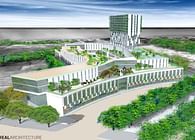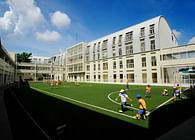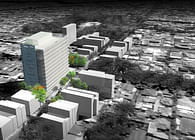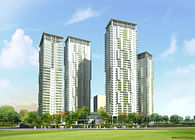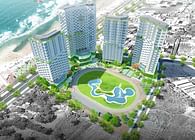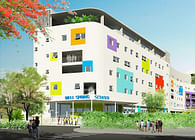
Ho Chi Minh City, VN
In keeping with Japanese principles of respect for place (from the earliest Shinto shrines through to the work of Tadao Ando) and Australian principles of respect for land (from the earliest Aboriginal cultures through to the work of Glen Murcutt), the design does not attempt to mimic vernacular building types, but rather to invent an entirely site-specific solution. The formal organization and material assembly of the building comprise a response to every aspect of the context: climate, topography, functional demands, sustainable objectives, locally available materials, as well as the anticipated budget and construction schedule.
An analysis of available techniques for energy-use reduction reveals that a completely autonomous, off-grid building would be unreasonably expensive. Instead, the environmental strategy is to offset power usage and supplement the local utilities through a combination of passive and active, low- and high-tech solutions. Within a super-insulated exterior shell, geothermally heated and cooled floor slabs combined with a dehumidifying system are used instead of conventional air-conditioning and heating units. In keeping with local traditions, steeply gabled roofs will deal with heavy winter snowfalls, and a long, narrow narrow building volume will allow summer cross-ventilation. Rain and snow are collected and stored within insulated underground tanks, to be utilized as a water supply as well as for cooling during summer.
For ease of maintenance and sensitivity to the local ecosystem, the landscaping uses only indigenous vegetation. The arrangement of the building on the site enables freedom of movement around and through it, and the operable outer walls allow interior and exterior space to be connected or separated as desired. Interior spaces may be flexibly subdivided to allow optimal heating and cooling of spaces. All the larger spaces are naturally lit and ventilated. Manipulation of the roof profiles together with the plan forms gives a spatial variety that enables work of different scales to be produced and displayed. At its center, the project embraces a generous courtyard: a space for display, relaxation, BBQs… the open heart that will foster a community among the artists and the locals.
Status: Competition Entry
Location: Japan
